The Romantic Manifesto: A Philosophy of Literature Read online
Page 3
The transition from guidance by a sense of life to guidance by a conscious philosophy takes many forms. For the rare exception, the fully rational child, it is a natural, absorbing, if difficult, process—the process of validating and, if necessary, correcting in conceptual terms what he had merely sensed about the nature of man’s existence, thus transforming a wordless feeling into clearly verbalized knowledge, and laying a firm foundation, an intellectual roadbed, for the course of his life. The result is a fully integrated personality, a man whose mind and emotions are in harmony, whose sense of life matches his conscious convictions.
Philosophy does not replace a man’s sense of life, which continues to function as the automatically integrated sum of his values. But philosophy sets the criteria of his emotional integrations according to a fully defined and consistent view of reality (if and to the extent that a philosophy is rational). Instead of deriving, subconsciously, an implicit metaphysics from his value-judgments, he now derives, conceptually, his value-judgments from an explicit metaphysics. His emotions proceed from his fully convinced judgments. The mind leads, the emotions follow.
For many men, the process of transition never takes place: they make no attempt to integrate their knowledge, to acquire any conscious convictions, and are left at the mercy of their inarticulate sense of life as their only guide.
For most men, the transition is a tortured and not fully successful process, leading to a fundamental inner conflict—a clash between a man’s conscious convictions and his repressed, unidentified (or only partially identified) sense of life. Very often, the transition is incomplete, as in the case of a man whose convictions are not part of a fully integrated philosophy, but are merely a collection of random, disconnected, often contradictory ideas, and, therefore, are unconvincing to his own mind against the power of his subconscious metaphysics. In some cases, a man’s sense of life is better (closer to the truth) than the kind of ideas he accepts. In other cases, his sense of life is much worse than the ideas he professes to accept but is unable fully to practice. Ironically enough, it is man’s emotions, in such cases, that act as the avengers of his neglected or betrayed intellect.
In order to live, man must act; in order to act, he must make choices; in order to make choices, he must define a code of values; in order to define a code of values, he must know what he is and where he is—i.e., he must know his own nature (including his means of knowledge) and the nature of the universe in which he acts—i.e., he needs metaphysics, epistemology, ethics, which means: philosophy. He cannot escape from this need; his only alternative is whether the philosophy guiding him is to be chosen by his mind or by chance.
If his mind does not provide him with a comprehensive view of existence, his sense of life will. If he succumbs to centuries of concerted assaults on the mind—to traditions offering vicious irrationality or unconscionable nonsense in the guise of philosophy—if he gives up, in lethargy or in bewilderment, evades fundamental issues and concerns himself only with the concretes of his day-by-day existence, his sense of life takes over: for good or evil (and, usually, for evil), he is left at the mercy of a subconscious philosophy which he does not know, has never checked, has never been aware of accepting.
Then, as his fear, anxiety and uncertainty mount year by year, he finds himself living with a sense of unknown, undefinable doom, as if in expectation of some approaching judgment day. What he does not know is that every day of his life is judgment day—the day of paying for the defaults, the lies, the contradictions, the blank-outs recorded by his subconscious on the scrolls of his sense of life. And on that kind of psychological record, the blank entries are the blackest sins.
A sense of life, once acquired, is not a closed issue. It can be changed and corrected—easily, in youth, while it is still fluid, or by a longer, harder effort in later years. Since it is an emotional sum, it cannot be changed by a direct act of will. It changes automatically, but only after a long process of psychological retraining, when and if a man changes his conscious philosophical premises.
Whether he corrects it or not, whether it is objectively consonant with reality or not, at any stage or state of its specific content, a sense of life always retains a profoundly personal quality; it reflects a man’s deepest values; it is experienced by him as a sense of his own identity.
A given person’s sense of life is hard to identify conceptually, because it is hard to isolate: it is involved in everything about that person, in his every thought, emotion, action, in his every response, in his every choice and value, in his every spontaneous gesture, in his manner of moving, talking, smiling, in the total of his personality. It is that which makes him a “personality.”
Introspectively, one’s own sense of life is experienced as an absolute and an irreducible primary—as that which one never questions, because the thought of questioning it never arises. Extrospectively, the sense of life of another person strikes one as an immediate, yet undefinable, impression—on very short acquaintance—an impression which often feels like certainty, yet is exasperatingly elusive, if one attempts to verify it.
This leads many people to regard a sense of life as the province of some sort of special intuition, as a matter perceivable only by some special, non-rational insight. The exact opposite is true: a sense of life is not an irreducible primary, but a very complex sum; it can be felt, but it cannot be understood, by an automatic reaction; to be understood, it has to be analyzed, identified and verified conceptually. That automatic impression—of oneself or of others—is only a lead; left untranslated, it can be a very deceptive lead. But if and when that intangible impression is supported by and unites with the conscious judgment of one’s mind, the result is the most exultant form of certainty one can ever experience: it is the integration of mind and values.
There are two aspects of man’s existence which are the special province and expression of his sense of life: love and art.
I am referring here to romantic love, in the serious meaning of that term—as distinguished from the superficial infatuations of those whose sense of life is devoid of any consistent values, i.e., of any lasting emotions other than fear. Love is a response to values. It is with a person’s sense of life that one falls in love—with that essential sum, that fundamental stand or way of facing existence, which is the essence of a personality. One falls in love with the embodiment of the values that formed a person’s character, which are reflected in his widest goals or smallest gestures, which create the style of his soul—the individual style of a unique, unrepeatable, irreplaceable consciousness. It is one’s own sense of life that acts as the selector, and responds to what it recognizes as one’s own basic values in the person of another. It is not a matter of professed convictions (though these are not irrelevant); it is a matter of much more profound, conscious and subconscious harmony.
Many errors and tragic disillusionments are possible in this process of emotional recognition, since a sense of life, by itself, is not a reliable cognitive guide. And if there are degrees of evil, then one of the most evil consequences of mysticism—in terms of human suffering—is the belief that love is a matter of “the heart,” not the mind, that love is an emotion independent of reason, that love is blind and impervious to the power of philosophy. Love is the expression of philosophy—of a subconscious philosophical sum—and, perhaps, no other aspect of human existence needs the conscious power of philosophy quite so desperately. When that power is called upon to verify and support an emotional appraisal, when love is a conscious integration of reason and emotion, of mind and values, then—and only then—it is the greatest reward of man’s life.
Art is a selective re-creation of reality according to an artist’s metaphysical value-judgments. It is the integrator and concretizer of man’s metaphysical abstractions. It is the voice of his sense of life. As such, art is subject to the same aura of mystery, the same dangers, the same tragedies—and, occasionally, the same glory—as romantic love.
Of all human prod
ucts, art is, perhaps, the most personally important to man and the least understood—as I shall discuss in the next chapter.
(February 1966)
3. Art and Sense of Life
IF ONE saw, in real life, a beautiful woman wearing an exquisite evening gown, with a cold sore on her lips, the blemish would mean nothing but a minor affliction, and one would ignore it.
But a painting of such a woman would be a corrupt, obscenely vicious attack on man, on beauty, on all values—and one would experience a feeling of immense disgust and indignation at the artist. (There are also those who would feel something like approval and who would belong to the same moral category as the artist.)
The emotional response to that painting would be instantaneous, much faster than the viewer’s mind could identify all the reasons involved. The psychological mechanism which produces that response (and which produced the painting) is a man’s sense of life.
(A sense of life is a pre-conceptual equivalent of metaphysics, an emotional, subconsciously integrated appraisal of man and of existence.)
It is the artist’s sense of life that controls and integrates his work, directing the innumerable choices he has to make, from the choice of subject to the subtlest details of style. It is the viewer’s or reader’s sense of life that responds to a work of art by a complex, yet automatic reaction of acceptance and approval, or rejection and condemnation.
This does not mean that a sense of life is a valid criterion of esthetic merit, either for the artist or the viewer. A sense of life is not infallible. But a sense of life is the source of art, the psychological mechanism which enables man to create a realm such as art.
The emotion involved in art is not an emotion in the ordinary meaning of the term. It is experienced more as a “sense” or a “feel,” but it has two characteristics pertaining to emotions: it is automatically immediate and it has an intense, profoundly personal (yet undefined) value-meaning to the individual experiencing it. The value involved is life, and the words naming the emotion are: “This is what life means to me.”
Regardless of the nature or content of an artist’s metaphysical views, what an art work expresses, fundamentally, under all of its lesser aspects is: “This is life as I see it.” The essential meaning of a viewer’s or reader’s response, under all of its lesser elements, is: “This is (or is not) life as I see it.”
The psycho-epistemological process of communication between an artist and a viewer or reader goes as follows: the artist starts with a broad abstraction which he has to concretize, to bring into reality by means of the appropriate particulars; the viewer perceives the particulars, integrates them and grasps the abstraction from which they came, thus completing the circle. Speaking metaphorically, the creative process resembles a process of deduction; the viewing process resembles a process of induction.
This does not mean that communication is the primary purpose of an artist: his primary purpose is to bring his view of man and of existence into reality; but to be brought into reality, it has to be translated into objective (therefore, communicable) terms.
In Chapter 1, I discussed why man needs art—why, as a being guided by conceptual knowledge, he needs the power to summon the long chain and complex total of his metaphysical concepts into his immediate conscious awareness. “He needs a comprehensive view of existence to integrate his values, to choose his goals, to plan his future, to maintain the unity and coherence of his life.” Man’s sense of life provides him with the integrated sum of his metaphysical abstractions; art concretizes them and allows him to perceive—to experience—their immediate reality.
The function of psychological integrations is to make certain connections automatic, so that they work as a unit and do not require a conscious process of thought every time they are evoked. (All learning consists of automatizing one’s knowledge in order to leave one’s mind free to pursue further knowledge.) There are many special or “cross-filed” chains of abstractions (of interconnected concepts) in man’s mind. Cognitive abstractions are the fundamental chain, on which all the others depend. Such chains are mental integrations, serving a special purpose and formed accordingly by a special criterion.
Cognitive abstractions are formed by the criterion of: what is essential? (epistemologically essential to distinguish one class of existents from all others). Normative abstractions are formed by the criterion of: what is good? Esthetic abstractions are formed by the criterion of: what is important?
An artist does not fake reality—he stylizes it. He selects those aspects of existence which he regards as metaphysically significant—and by isolating and stressing them, by omitting the insignificant and accidental, he presents his view of existence. His concepts are not divorced from the facts of reality—they are concepts which integrate the facts and his metaphysical evaluation of the facts. His selection constitutes his evaluation: everything included in a work of art—from theme to subject to brushstroke or adjective—acquires metaphysical significance by the mere fact of being included, of being important enough to include.
An artist (as, for instance, the sculptors of Ancient Greece) who presents man as a god-like figure is aware of the fact that men may be crippled or diseased or helpless; but he regards these conditions as accidental, as irrelevant to the essential nature of man—and he presents a figure embodying strength, beauty, intelligence, self-confidence, as man’s proper, natural state.
An artist (as, for instance, the sculptors of the Middle Ages) who presents man as a deformed monstrosity is aware of the fact that there are men who are healthy, happy or confident; but he regards these conditions as accidental or illusory, as irrelevant to man’s essential nature—and he presents a tortured figure embodying pain, ugliness, terror, as man’s proper, natural state.
Now consider the painting described at the start of this discussion. The cold sore on the lips of a beautiful woman, which would be insignificant in real life, acquires a monstrous metaphysical significance by virtue of being included in a painting. It declares that a woman’s beauty and her efforts to achieve glamor (the beautiful evening gown) are a futile illusion undercut by a seed of corruption which can mar and destroy them at any moment—that this is reality’s mockery of man—that all of man’s values and efforts are impotent against the power, not even of some great cataclysm, but of a miserable little physical infection.
The Naturalistic type of argument—to the effect that, in real life, a beautiful woman might get a cold sore—is irrelevant esthetically. Art is not concerned with actual occurrences or events as such, but with their metaphysical significance to man.
An indication of the metaphysical slant of art can be seen in the popular notion that a reader of fiction “identifies himself with” some character or characters of the story. “To identify with” is a colloquial designation for a process of abstraction: it means to observe a common element between the character and oneself, to draw an abstraction from the character’s problems and apply it to one’s own life. Subconsciously, without any knowledge of esthetic theory, but by virtue of the implicit nature of art, this is the way in which most people react to fiction and to all other forms of art.
This illustrates one important aspect of the difference between a real-life news story and a fiction story: a news story is a concrete from which one may or may not draw an abstraction, which one may or may not find relevant to one’s own life; a fiction story is an abstraction that claims universality, i.e., application to every human life, including one’s own. Hence one may be impersonal and indifferent in regard to a news story, even though it is real; and one feels an intensely personal emotion about a fiction story, even though it is invented. This emotion may be positive, when one finds the abstraction applicable to oneself—or resentfully negative, when one finds it inapplicable and inimical.
It is not journalistic information or scientific education or moral guidance that man seeks from a work of art (though these may be involved as secondary consequences), but the fulfillment of a
more profound need: a confirmation of his view of existence—a confirmation, not in the sense of resolving cognitive doubts, but in the sense of permitting him to contemplate his abstractions outside his own mind, in the form of existential concretes.
Since man lives by reshaping his physical background to serve his purpose, since he must first define and then create his values—a rational man needs a concretized projection of these values, an image in whose likeness he will re-shape the world and himself. Art gives him that image; it gives him the experience of seeing the full, immediate, concrete reality of his distant goals.
Since a rational man’s ambition is unlimited, since his pursuit and achievement of values is a lifelong process—and the higher the values, the harder the struggle—he needs a moment, an hour or some period of time in which he can experience the sense of his completed task, the sense of living in a universe where his values have been successfully achieved. It is like a moment of rest, a moment to gain fuel to move farther. Art gives him that fuel; the pleasure of contemplating the objectified reality of one’s own sense of life is the pleasure of feeling what it would be like to live in one’s ideal world.
“The importance of that experience is not in what man learns from it, but in that he experiences it. The fuel is not a theoretical principle, not a didactic ‘message, ’ but the life-giving fact of experiencing a moment of metaphysical joy—a moment of love for existence.” (See Chapter 11.)
The same principle applies to an irrational man, though in different terms, according to his different views and responses. For an irrational man, the concretized projection of his malevolent sense of life serves, not as fuel and inspiration to move forward, but as permission to stand still: it declares that values are unattainable, that the struggle is futile, that fear, guilt, pain and failure are mankind’s predestined end—and that he couldn’t help it. Or, on a lower level of irrationality, the concretized projection of a malignant sense of life provides a man with an image of triumphant malice, of hatred for existence, of vengeance against life’s best exponents, of the defeat and destruction of all human values; his kind of art gives him a moment’s illusion that he is right—that evil is metaphysically potent.

 Anthem
Anthem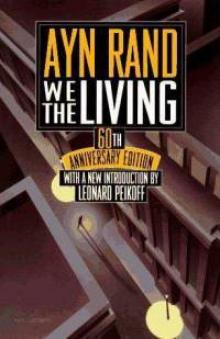 We the Living
We the Living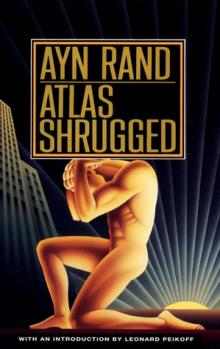 Atlas Shrugged
Atlas Shrugged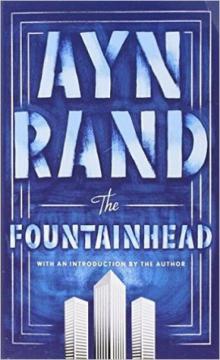 The Fountainhead
The Fountainhead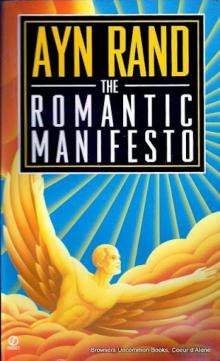 The Romantic Manifesto: A Philosophy of Literature
The Romantic Manifesto: A Philosophy of Literature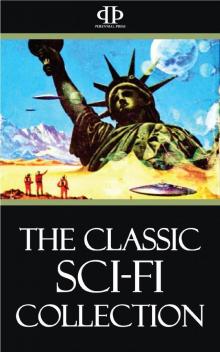 The Classic Sci-Fi Collection
The Classic Sci-Fi Collection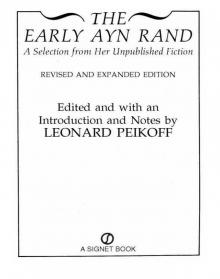 The Early Ayn Rand
The Early Ayn Rand